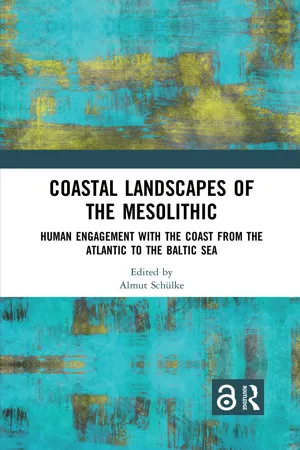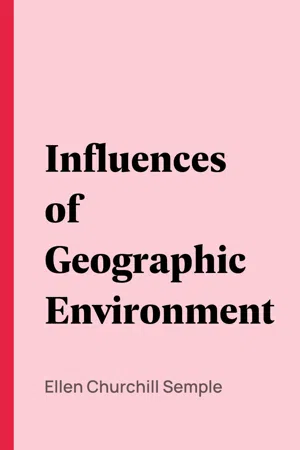Coastlines
Coastlines refer to the boundary between land and water, where the land meets the sea or ocean. They are dynamic and constantly changing due to natural processes such as erosion, deposition, and tectonic activity. Coastlines are important geographical features that support diverse ecosystems, human settlements, and economic activities.
6 Key excerpts on "Coastlines"
- eBook - ePub
- John Roff, John Roff(Authors)
- 2013(Publication Date)
- Routledge(Publisher)
...However, there is still little agreement as to where the coastal zone even begins or ends. Some definitions of the coast: ‘The general area between land and sea’, or coastal zone: ‘The interface between land and water’, are too vague. Other definitions are too inclusive: ‘The regions of the continental shelves up to and including the watersheds whose drainage influences the region.’ The last definition would encompass most of the neritic zone and indeed much of the terrestrial environment. There is an obvious need for clear operational definitions, because the coastal zone is where humans most strongly interact with the oceans. The Encyclopedia of Earth gives the following definition: The coastal ocean is the portion of the global ocean where physical, biological and biogeochemical processes are directly affected by land. It is either defined as the part of the global ocean covering the continental shelf or the continental margin. The coastal zone usually includes the coastal ocean as well as the portion of the land adjacent to the coast that influences coastal waters. It can readily be appreciated that none of these concepts has a clear operational definition. Source: Adapted from Ray and McCormick-Ray (2004) and University of Liverpool Encyclopedia of Earth Figure 11.1 Showing various definitions and extents of the coastal realm and coastal zone Again, by following this definition, the coastal zone would seem to include the entire continental shelf and any land (all of any island, and most of any continental land mass) that drains into the oceans. More realistically from an ecological perspective, and more restrictively, the coastal zone might be defined by: seaward – the extent of the fringing communities (i.e. the depth limit of the benthic euphotic zone, some 30–50m in temperate waters); and landward – by the extent of beaches, cliffs and headlands (i.e...
- eBook - ePub
Coastal Landscapes of the Mesolithic
Human Engagement with the Coast from the Atlantic to the Baltic Sea
- Almut Schülke, Almut Schülke(Authors)
- 2020(Publication Date)
- Routledge(Publisher)
...Today, these coastal zones are delimited by but also connected through the northeastern parts of the Atlantic Ocean and its marginal seas, including the Irish Sea, the North Sea, the Norwegian Sea, the Skagerrak, the Kattegat and the Baltic Sea (Figure 1.1). Figure 1.1 The coastal areas between the Atlantic Ocean and the Baltic Sea. The areas dealt with in this book are marked with their chapter number: 2: Jutland (Denmark); 3, 8, 11, 13, 15: southeastern Norway and the Oslo fjord region (Norway); 4: Ireland; 5: Latvia; 6: central Norway; 7: western Scotland; 9: western France; 10: western Norway; 12: the Baltic Sea area (Denmark, northeastern Germany, Poland, Lithuania, Estonia, eastern Sweden); 14: southern Norway; 16: Lolland (Denmark). Illustration: A. Schülke. Though connected, these seas are different in character, across space and time, with differing environments and temporalities, due to their different geological, geographical, oceanographic and climatic conditions and developments. Different types of land meet different kinds of seas with varying resources. These shorelines, as a junction between fast and fluid, wet and dry, warm and cold, salty and brackish and so forth, have many different facets and were prioritized and utilized differently at different times. The varying character of coastal zones across geographic regions, their formation and human use through time have had an impact on research traditions and methods, which responded differently to the prehistoric remains preserved in the different areas. As we will see, they create interesting tensions between research landscapes in the different regions. The notion ‘landscape’ is complex, and can have many meanings and connotations (Bender 1993; Thomas 2001; David et al. 2014). It can denote a specific geographic area with specific topographic, climatic, environmental and cultural characteristics in the sense of a surface...
- Gerd Masselink, Michael Hughes, Jasper Knight(Authors)
- 2014(Publication Date)
- Routledge(Publisher)
...CHAPTER 1 COASTAL SYSTEMS AIMS This chapter outlines how the coastal zone can be defined and discusses the properties and characteristics of systems, highlighting the importance of sedimentary processes and concepts such as self-organisation. Consideration of systems is useful because it provides a framework by which the dynamic behaviour of geomorphological processes and landforms can be understood. 1.1 Introduction This book is about coastal processes and geomorphology. The spatial boundaries of the coastal zone as considered in this book are defined in Figure 1.1 and follow the definitions set out by Inman and Brush (1973). The upper and lower boundaries correspond to the elevational range over which coastal processes have operated during the Quaternary period, and include the coastal plain, the shoreface and the continental shelf. During the Quaternary (from 2.6 million years ago until present), sea level fluctuated over up to 135 m vertically due to expansion and contraction of ice sheets and warming and cooling of the oceans. The landward limit of the coastal system therefore includes the coastal depositional and marine erosion surfaces formed when sea level was high (at or just above its present-day position) during global warm periods. The lowest sea levels, during global cold periods, placed coastal processes close to the edge of the continental shelf. The seaward limit of the coastal system is therefore defined by the continental shelf break, which typically occurs in water depths of 100–200 m. Changes in global climate during the Quaternary markedly shifted the position of the coastal zone, changing coastal geography particularly in areas with extensive shelves (Case Study 1.1). Many of today’s coastal landscapes reflect their Quaternary (and older) geological inheritance, and are responding dynamically to human activity in the coastal zone and ongoing global warming...
- eBook - ePub
Influences of Geographic Environment
On the Basis of Ratzel's System of Anthropo-Geography
- Ellen Churchill Semple(Author)
- 2005(Publication Date)
- Perlego(Publisher)
...Chapter VII—Geographical Boundaries The boundary zone in nature. Nature abhors fixed boundary lines and sudden transitions; all her forces combine against them. Everywhere she keeps her borders melting, wavering, advancing, retreating. If by some cataclysm sharp lines of demarcation are drawn, she straightway begins to blur them by creating intermediate forms, and thus establishes the boundary zone which characterizes the inanimate and animate world. A stratum of limestone or sandstone, when brought into contact with a glowing mass of igneous rock, undergoes various changes due to the penetrating heat of the volcanic outflow, so that its surface is metamorphosed as far as that heat reaches. The granite cliff slowly deposits at its base a rock-waste slope to soften the sudden transition from its perpendicular surface to the level plain at its feet. The line where a land-born river meets the sea tends to become a sandbar or a delta, created by the river-borne silt and the wash of the waves, a form intermediate between land and sea, bearing the stamp of each, fluid in its outlines, ever growing by the persistent accumulation of mud, though ever subject to inundation and destruction by the waters which made it. The alluvial coastal hems that edge all shallow seas are such border zones, reflecting in their flat, low surfaces the dead level of the ocean, in their composition the solid substance of the land; but in the miniature waves imprinted on the sands and the billows of heaped-up boulders, the master workman of the deep leaves his mark. [See map page 243.] Under examination, even our familiar term coastline proves to be only an abstraction with no corresponding reality in nature. Everywhere, whether on margin of lake or gulf, the actual phenomenon is a coast zone, alternately covered and abandoned by the waters, varying in width from a few inches to a few miles, according to the slope of the land, the range of the tide and the direction of the wind...
- eBook - ePub
The Geography of Tourism and Recreation
Environment, Place and Space
- C. Michael Hall, Stephen J. Page(Authors)
- 2014(Publication Date)
- Routledge(Publisher)
...Heritage Coastline and Area of Outstanding Natural Beauty in England and Wales), the impacts of tourism and recreation are multifaceted. In the wide-ranging study by the German Federal Agency for Nature Conservation (1997), the dominant coastline regions globally were the Mediterranean, the Caribbean, the Gulf of Mexico, the Indian Ocean islands, Australasia and the Pacific islands. In this context, the coastal resource is a global environmental issue which is complex, diverse and not simply reduced to beach resorts, as the discussion has alluded to so far. (See Visser and Njunga’s (1992) examination of the Kenyan coastline, where the ecological diversity in the coastal environment comprises coral reefs, sea grass and seaweed beds, mangrove forests, sand dunes and inland tropical forests.) According to the German Federal Agency for Nature Conservation (1997), coastal tourism environments may be categorised as follows: oceanic islands; coral reefs; offshore waters; mangroves; near-coastal wetlands; sandy beaches; coastal dunes. The environments under the greatest recreational and tourism pressure are sandy beaches, followed by coastal dunes (see Nordstom et al. 2000 for a review of management practices to restore dunes). Within a European context, the principal erosion and sedimentation processes affecting coastal environments are related to natural processes, including: wave and tidal action; geomorphological factors (e.g. rivers which impact upon the river mouth and deltas); meteorological factors (e.g. wind and storms); changes in sea level; geological processes (e.g. seismic and volcanic activity). In addition, the European coastline is also subjected to a great number of environmental stresses, to the point where some researchers consider it to be under the greatest pressure of any coastal environment globally (German Federal Agency for Nature Conservation 1997; Hall 2006c). For example, Jiménez et al...
- eBook - ePub
- Rattan Lal(Author)
- 2017(Publication Date)
- CRC Press(Publisher)
...1). It is utterly dependent upon where you happen to be standing. There is a huge difference between “what the eye can comprehend” (see) from a mountain top vs. the view from a coastal plain marsh. This perspective depends exclusively upon your field of view. It encompasses everything, and yet only, what you happen to see (doesn’t address things out-of-view). 2. Explicit Geomorphic context — e.g., mountains (any mountains) vs. plains (any plains) : “Landscape—a broad or unique land area comprised of an assemblage or collection of natural landforms that define a general geomorphic form or setting (e.g., mountain range, lake plain, river valley, etc.). Landforms within a landscape share spatially associated formational processes but can vary in details and age.” [ 2 ] This context recognizes landform groups that are spatially associated in a unique, recognizable pattern (clustered, oriented, and arranged) indicating a common link (Fig. 2). The link(s) may be similar topography (elevation and relief), composition (bedrock or sediment types), structure (tectonic, crustal deformations), surficial modification (erosional or depositional alterations), etc. and are tangibly different from adjoining landform groups. If landscape subtypes (e.g., different types of mountains) are recognized, the emphasis is on specific geologic or geomorphic attributes (e.g., fault-block mountains vs. volcanic mountains) rather than differences in climate, vegetation, or geography (e.g., the Organ Mountains vs. the Cascade Mountains). A list of common landscapes is shown in Table 1. 3. Physiographic context : Landscape—a collection or group of individual landforms that are spatially associated in a unique, recognizable pattern (clustered, oriented, and arranged) indicating common links. The links are not restricted to geomorphic and geologic parameters but may also include geography (where on a continent), native plant communities (desert vs...





